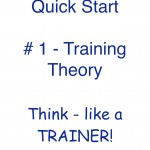 Steps to Success
Steps to Success
– Dog Training Theory
– Too often, a puppy is brought into the home and our methods of teaching consist of “screaming no” and “swatting with a newspaper”. I know that’s how I did it before I learned about animal learning and behavior! How primitive.
Stubborn Dogs
Many clients begin our conversations by exclaiming their dogs know Sit and Come, but refuse to perform. The next phrases during these discussions are “she refuses to listen to me when visitors come into the house”, or “she refuses to come inside when I call her.” She knows what she is supposed to do, but she is stubborn”
My experiences have taught me that it’s rarely a stubborn refusal to sit or come.
Training method flaws and lofty expectations are the root causes for these failures.
In many cases the client doesn’t understand how to motivate their dogs to comply. In other cases, the client has never practiced in those situations and the dogs are not prepared to succeed.
The dogs cannot match the owners’ expectations because the owners have not prepared the dogs for real life environments.
Many of us expect college level performances from a dog that has only been practicing in kindergarten settings.
Our dogs need to practice in controlled environments before we can expect them to perform in exciting situations.
Door Manners
For example, suppose your goal is teach your pup to ‘relax-when-people-visit’. Identify all the skills and behaviors that make up ‘relax-when-people-visit’ behavior. Teach and practice each skill with various levels of distractions.
First you might teach the dog to sit, down, and relax inside your house when it is quiet. Next, you might practice when house members are sitting…. standing…. walking….. passing doorways……waving their arms, clapping, jumping, et cetera.
Once your dog can sit, down and relax inside the house with house members as the distractions, you start all over and practice with family members entering the house. Finally, you practice the same sequences with willing visitors.
You should hold these practice sessions when you have total control of the classroom environment. That is – when you can guide your dog into choosing the correct behaviors. Set up the environment so your dog has limited choices of which behaviors to perform. Once he masters the current level of distraction, introduce another, higher level distraction.
During these well planned practice sessions, your dog has only a few choices. Because you have a leash attached, none of those choices include mug-the-people behaviors!
Edward Thorndike’s Law of Effect
“Of several responses made to the same situation, those which are accompanied or closely followed by satisfaction to the animal will, other things being equal, be more firmly connected with the situation, so that, when it recurs, they will be more likely to recur; those which are accompanied or closely followed by discomfort to the animal will, other things being equal, have their connections with that situation weakened, so that, when it recurs, they will be less likely to occur. The greater the satisfaction or discomfort, the greater the strengthening or weakening of the bond.”
The law of effect is the idea that behaviors are selected by their consequences. Behaviors that are followed by a pleasing or wanted situation are repeated . Therefore behavior that is repeated is often followed by a desired consequence and behavior that is not repeated had previously been followed by a unwanted consequence.
The key to animal friendly teaching is to initially get the animal to perform the behavior and then reinforce the behavior via positive reinforcement or rewards.
The steps for perfecting all new behaviors are identical.
- Tell your dog when it occurs.
- Deliver some sort of reward.
- Practice the behavior in various, controlled settings while adding distractions.
- Practice the behavior in real life.
Get the Behavior
I’m sure you’ve noticed. It’s impossible to use positive reinforcement to increase behaviors if the behaviors never occur.
There are all sorts of actions one can use to get a particular behavior to occur. For instance, standing and leaning into a dog’s space might a useful tool for getting the dog to sit. If you use this tool, don’t forget to move back into a neutral position the instant the dog sits.
Other dogs move away when you crowd their space. When teaching these dogs, stepping away or leaning out of the dog’s space might be useful tools for getting the sit to happen.
Both of these body movements (leaning in or out) have an effect on the environment; sometimes the effect is useful, other times it’s not. It depends on the dog, the environment, the handler, et cetera.
Professional trainers are experts at getting the behavior to occur; not because we know exactly what will work with every animal, but because we are constantly and delicately changing the environment until we “get” the desired behavior.
Professional trainers are always aware of body language, tone of voice, value of the food treats, dog’s state of hunger, distractions, et cetera.
We manipulate these and other conditions in the environment until we get the behavior. Sooner than later, we hit on the right combination.
There are many methods to get behaviors, some work well for already learned behaviors and others are for teaching.
Here is a list of methods that trainers use to get a behavior to occur.
- Cue
- Capture
- Lure
- Shape
- Target
Canine Success
- Meet your dog’s social, emotional and physical needs.
- Kindly prevent your pet from practicing unwanted behaviors.
- Learn how to tell your dog exactly what you want.
- Learn how to motivate your dog to want the same things as you.
- Change your behaviors in order to change your dog’s behaviors.
- Crate train your puppy. (a crate trained pup will relax in the crate when the family is home and throwing a party.)
- House train your puppy.
- Teach your puppy about play biting.
- Socialize your puppy.
- Form a global training plan.
- Teach your dog coping skills.
- Teach your dog basic commands.
- Practice with your dog every day.
- Practice with your dog in many different locations.
- Practice with your dog while increasing the level of distractions.
- Practice with your dog on a short leash, and then on a long line – before you go off leash.
Off Leash Obedience
Off leash obedience is an advanced skill.
Master all commands on a short leash, and then practice at a distance on a long line. Practice in areas with few distractions, then in areas with more distractions – on a long line.
Once your dog will obey on the long line in all situations, then you can go off lead!
Happy Training!
Alan J Turner, Companion Animal Behavior Counselor & Trainer – Canine Specialization
Private and Group Dog Training in Memphis, TN
Owner: How’s Bentley
 I always ask my clients to practice with their dogs during short sessions throughout the day. For puppies and dogs that are learning look and sit (the first 2 commands), I recommend 5 sessions each day, for 60 seconds per session.
I always ask my clients to practice with their dogs during short sessions throughout the day. For puppies and dogs that are learning look and sit (the first 2 commands), I recommend 5 sessions each day, for 60 seconds per session. 


 Steps to Success
Steps to Success